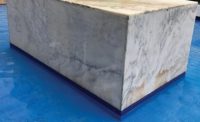“They didn’t come in seeking custom handmade tile,” said Tiffany Ferraro, designer and co-owner of Earthstone Tile Works of Philadelphia, PA, which was the tile distributor and installer for the project. “The goal was to have something unique. It’s a small space. They wanted something that was beautiful, because it is the first thing you see when you walk in [the home]. As soon as they saw Lilywork — it is a big focal point in our showroom — they loved it. [Also], the tile makers are about an hour away. People love supporting a local business.
“I designed the whole foyer based on color,” Ferraro went on to explain. “We did kind of a traditional vestibule with field tile around the center and created interest in the center. We wanted to make it look like a rug.”
According to the designer, the clients selected their favorite pieces, and she developed the design from there. “They liked the star and cross, and I added details,” she said. “Instead of just using 6- x 6-inch tiles, we started with 3- x 6-inch pieces. It is very traditionally done for handmade tiles.”
Ferrara also explained that her inspiration came from the Trent tile vestibules that are found in the area. “You see them everywhere in South Philly,” she said. “Lilywork is similar. The colors are not bright and poppy. They are muted — something you would see in the early 1900s.”
Esther Halferty, co-owner of Lilywork with her husband Paul, agrees that the custom handmade tile complements the home’s age. “The colors and patterning coordinates with tile from 100 years ago,” she said. “We did custom cuts to frame the stars and crosses. Mosaic patterning is such a nice look for floor inserts.”
Halferty explained that the focal point of the floor design consists of “Monreale”/star+cross tessellated field surrounded by plain field. Complementing the floor pattern is a wall border of “Ravenna” tessellated listello.
In all, the tile-making process requires approximately four weeks to complete. “It takes about three days to press or hand-cut the tiles, and then they dry for a week,” said Halferty. “The tiles are then bisque-fired, which is a three-day process of loading, firing, cooling and unloading. Next, the tiles are glazed and loaded into kiln/s. The glaze-firing is also a three-day process. Finally, the smaller mosaic sections are mesh-mounted, and the order is packed.”
Ferrara explained that the homeowners are actually friends of her and her husband. “They live around the corner from our store,” she said. “We get to see the vestibule often. They are over the moon about it.”




